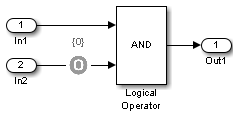Test Objective
Define custom objectives that signals must satisfy in test cases
Libraries:
Simulink Design Verifier /
Objectives and Constraints
Description
When operating in test generation mode, the Simulink® Design Verifier™ software produces test cases that satisfy the specified criteria (see Workflow for Test Generation). In this mode, you can use Test Objective blocks to define custom test objectives for signals in your model. The Values parameter lets you specify values that a signal must achieve for at least one time step during a test case simulation. The block applies the specified Values parameter to its input signal, and the Simulink Design Verifier software attempts to produce test cases that satisfy the objective.
The block's parameter dialog box also allows you to
Enable or disable the objective.
Specify that the block should display its Values parameter in the Simulink editor.
Specify that the block should display its output port.
Note
The Simulink and Simulink Coder™ software ignore the Test Objective block during model simulation and code generation, respectively. The Simulink Design Verifier software uses the Test Objective block only when generating test cases for a model.
Examples
Ports
Input
Parameters
Extended Capabilities
Version History
Introduced in R2007a


